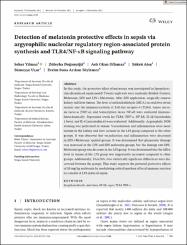Detection of melatonin protective effects in sepsis via argyrophilic nucleolar regulatory region-associated protein synthesis and TLR4/NF-κB signaling pathway

View/
Access
info:eu-repo/semantics/embargoedAccessDate
2022Author
Yılmaz, SeherDoğanyiğit, Züleyha
Oflamaz, Aslı Okan
Ateş, Şükrü
Uçar, Sümeyye
Arıkan Söylemez, Evrim Suna
Metadata
Show full item recordCitation
Yilmaz, S., Doğanyiğit, Z., Oflamaz, A. O., Ateş, Ş., Uçar, S., & Söylemez, E. S. A. (2023). Detection of melatonin protective effects in sepsis via argyrophilic nucleolar regulatory region‐associated protein synthesis and TLR4/NF‐κB signaling pathway. Chemical Biology & Drug Design, 101(4), 915-926.Abstract
In this study, the protective effect of melatonin was investigated in lipopolysaccharide induced sepsis model. Twenty-eight rats were randomly divided: Control, Melatonin, LPS and LPS + Melatonin. After LPS application, surgically remove kidney and liver tissues. The level of malondialdehyde (MDA) an oxidative stress marker and the immunoreactivity of Toll-like receptor-4 (TLR4), tumor necrosis factor-α (TNF-α), and transcription factor NF-κB were evaluated immunohistochemically. Expression levels for TLR4, TNF-α, NF-kB, IL-1β (interleukin 1 beta), and IL-6 (interleukin 6) were evaluated. Additionally, Argyrophilic NOR staining was performed in tissues. Vacuolization and inflammation were more intense in the kidney and liver sections in the LPS group compared to the other groups. It was observed that vacuolization and inflammation were decreased in LPS + Melatonin applied groups. It was determined that glomerular damage was increased in the LPS and LPS-melatonin groups, but the damage rate LPS-Melatonin group was decrease in the LPS group. It was determined that the MDA level in tissues of the LPS group was importantly increased compared to other groups. Additionally, TAA/NA ratio statistically significant differences were discovered between the groups. This study supports the potential protective effects of 10 mg/kg melatonin by modulating critical markers of local immune reaction in a model of LPS-induced sepsis.















